Tamarind: Origins - Consumption - Nutrition Facts - Health Benefits
|
|
|
Contents
- Geographic origin and regions grown
- Common consumption today
- Nutrition Facts: Vitamins, minerals and phytochemical components
- Health Benefits: Medicinal uses based on scientific studies
- Bibliography
Geographic Origins and Regions Grown

The tropical tree Tamarind originated in tropical Africa and parts of the Madagascar where there are dry deciduous forests. Although having been so long in India it is often stated as originating there as well hence the term from the Middle East referring to it as "tamar hindi" or Indian date. The fruit can be dated back to ancient Egypt and Greece in the 4th Century B.C.
Common Consumption Today
The tamarind, or Indian date from the date-like appearance of the dried pulp, is a curved brown bean-pod. Sticky pulp encasing one to ten shiny black seeds is inside. Pulp of the tamarind is sweet and sour with a fruity scent and taste.
With the tamarind you can choose your flavor. If you are looking for tart then the hard green pulp of the young tamarind is what you seek. This variety is used in many savory dishes including seasoning rice and fish or meats as in India. If you like sweet then go with the ripened tamarind fruit which is sweet with a hint of sour. For you dessert foodies this is the tamarind for you. It can be used in desserts, sweetened drinks, or as a fruit snack. The completely ripe fruit is enjoyed by adults and children. Thailand is actually cultivating a sweet variety with a tinier hint to no hint at all of the tamarind’s tartness, which is just to be consumed as a fresh fruit.
Being edible and popular, its many uses are found bottled, pressed or dried. It can be found worldwide in specialty stores. It is available as a bottled thick jam-like concentrate, as a pressed fibrous slab, or as dried pods in some Indian shops. In Asia and Latin America it is a spice. It is an ingredient in Worcestershire sauce, some barbecue sauces and “tamarind fish”, an Indian seafood pickle. It is available in many snack forms: either dried and salted or candied. It is a beverage. It is in your favorite Thai dish, perhaps Pad Thai or Sweet and Sour Deep-Fried Fish.
You can recognize the fruits that are dehydrated due to their light weight and hollow sound. You can tap to test the dry exterior shell. Pull the shell and the lengthwise fibers can be removed as you hold the stem and slip the pulp down.
If you want to try your hand at a confection, try sugared tamarind also called tamarind balls in the Caribbean. Prepare the tamarind by separating the seeds from the pulp; there is no need to use water. Use ripe, fresh, non-dehydrated tamarinds and press the hollowed and de-fibered fruit through a sieve all the while adding sugar in powdered form, so that the pulp no longer sticks to your fingers. Shape the seeded pulp into balls and coat with powdered sugar. If dehydrated tamarinds are the only available source then you can place the hollowed fruits with sugar that is granulated into a baking dish and cook in a oven that is already warm for around 4 hours or until all of the sugar melts, then rub the mass through, mixing the sugar to create a paste before rolling into balls.
A common drink that is used in the tropics is Tamarind ade, which can be found in the carbonated form throughout Central and South America and elsewhere. A simple home version of getting the ade ready is to hollow the fruits, then put 3-4 in a bottle (water) and let it sit for a little while, then add a table spoonful of sugar and mix thoroughly. If you are interested in making the beverage a little richer, cover the hollowed tamarinds with warm syrup (sugar) and let it sit for several days.
Nutrition Facts: Vitamins, Minerals and Phytochemical Components

This fruit is high in carbohydrates, sugars and fatty acids with correspondingly high calorie levels. It is rich in minerals Potassium, Phosphorus, Magnesium and Calcium as well as vitamins Niacin and Thiamin. It is consequently a good nutritional fruit.
The leaves and roots contain the glycosides vitexin, isovitexin, orientin and isoorientin. The bark yields the alkaloid, hordenine.
Health Benefits: Medicinal Uses Based on Scientific Studies
The medicinal uses for tamarind have yet to be fully measured but without a wealth of scientific evidence, the United State alone reportedly imports 200,000 pounds of shelled tamarinds annually for medicinal formulations.
In cases of paralysis, the pulp of the tamarind is said to aid the restoration of sensation. That is impressive. As a highly acidic fruit, the tamarind is a refrigerant (cooling in the heat) and febrifuge (for fighting fevers). It is also administered to alleviate sunstroke (1).
It is thought of as a mild laxative. It is used to treat bronchial disorders and sore throats (gargle with tamarind water for comfort). The pulp may be put on parts of the body swollen with inflammation as a treatment. It is antiseptic, used in eye-baths and for the treatment of ulcers. It is quite useful for Datura poisoning, alcoholic intoxication and to reverse the effect of an overdose of false chaulmoogra, used as a treatment for leprosy.
The leaves and the flowers are useful as well and can be boiled or dried for use as poultices on sprains, swollen joints and boils. They can be used to prepare extracts useful in cases of dysentery, jaundice, erysipelas, hemorrhoids, conjunctivitis, and as an antiseptic to get rid of worms or parasites from the intestines. The shells have proved to be useful too, and are burned down until they are just an ash for use in other natural remedies.
Its bark is used as a tonic, astringent and to treat fever as well. It is commonly fried, salted and crushed finely to reduce colic in babies and indigestion in adults. An extract is used for treating asthma, gingivitis and eye inflammations. Bark extracts or poultices are used to heal open sores.
Powdered tamarind seeds make a paste for getting rid of boils and, combined with or without cumin and palm sugar, can be used for diarrhea. The seed coat is quite astringent, but it is common to use it for diarrhea as well. For chest complaints, a tamarind root tea may have a positive effect.
Bibliography
1. Kuchel, J. M., Barnetson, R. S. C., Zhuang, L., Strickland, F. M., Pelley, R. P., & Halliday, G. M. (2005). Tamarind inhibits solar-simulated ultraviolet radiation-induced suppression of recall responses in humans. Letters in Drug Design and Discovery, 2(2), 165-171.
Disclaimer
Nutritiousfruit.com provides this website as a service. Although the information contained within the website is periodically updated, no guarantee is given that the information provided is correct, complete, and/or up-to-date. The materials contained on this website are provided for general information purposes only and do not constitute legal or other professional advice on any subject matter. Nutrtiousfruit.com does not accept any responsibility for any loss, which may arise from reliance on information contained on this website. The information and references in this website are intended solely for the general information for the reader. The content of this website are not intended to offer personal medical advice, diagnose health problems or to be used for treatment purposes. It is not a substitute for medical care provided by a licensed and qualified health professional. Please consult your health care provider for any advice on medications.
Didn't find what you were looking for? Search here...

Amazon Search Box:
Did you like this page?
|
|
|




